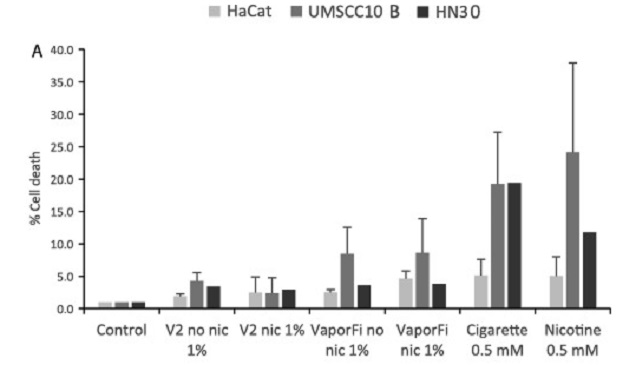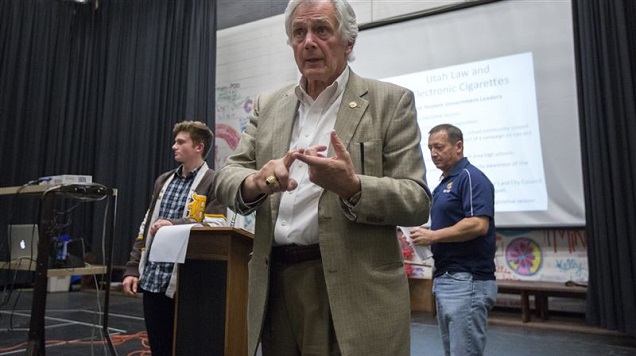
The Week in Vaping is back! Here’s your weekly update on all things vaping, coming back for a slightly early edition after a break for Christmas. So what’s been going on in the world of vaping? With claims that e-cigarettes are going to give us all cancer, more bans on vaping in Malaysian regions, some irrational state legislation proposed in the US, some positive coverage in the mainstream media, several excellent blog posts from vapers and a new coalition of students dedicated to spreading more bullshit about e-cigarettes, it’s the Week in Vaping.
E-Cigarette Research
Vaping is going to give us all cancer, according to pretty much everyone in the media. The study that led to all this panic – conveniently hitting the news in time for potential New Years’ resolutions – was accompanied by a press release that led with the claim that changes seen in cells exposed to e-cigarette vapor were “damaged … in ways that could lead to cancer.” It only gets worse with the comment from researcher Jessica Wang-Rodriguez later on:
Based on the evidence to date, I believe [e-cigarettes] are no better than smoking regular cigarettes.
What did the study actually find? Treating cells with e-cigarette vapor every three days for a maximum of eight weeks leads to increased cell death and causes DNA strand breaks. But as a cell study – i.e. looking at a disembodied sample of human in a petri dish – there are pretty obvious problems with concluding that much based on them alone. The bigger issue, though, is that the cells exposed to cigarette smoke all died, so they could only be exposed for 24 hours. Even the shorter exposure to cigarette smoke shows worse effect than vapor, so Wang-Rodriguez’s comments are completely and utterly baffling. It would have won Bullshit of the Week if it didn't fit so neatly in alongside the discussion of the study.

There are many other issues with the study and (especially) its coverage, well-summarized in Clive Bates’ post about it, but with great posts from the Stats Guy, Linda Bauld, Tom Pruen, Fergus Mason and Paul Barnes covering the research too. The short version, as usual, is that the study was blown out of proportion thanks to the rampant sensationalism of the press release and the credulity of journalists.
A study has also found that e-cigarette ads don’t appear to have any impact on the appeal of smoking or vaping in non-smoking teens. This may be shocking to anyone who thinks teens are mindless slaves to advertising, or who’s bought into the whole anti-vaping gateway narratives.
One-man pro-vaping news machine Guy Bentley also covered another recent study from France , which estimates that 400,000 people in France have quit smoking thanks to vaping.
Legislation, Regulations and Vaping Bans
E-cigarette retailers in Malaysia have filed an injunction at the High Court in Kuala Lumpur to get some clarification on the situation for vaping in Malaysia. Previously, two states banned the sale of vaping devices and ordered vape shops to close and another (Terengganu) has joined them in the wake of the recent declaration of vaping as haram (prohibited) by Malaysia’s National Fatwa Council. There have even been raids on vape stores. Understandably, many small and medium business are unsure of the legal situation and are urging states to follow the government’s slightly more measured approach.
Spokane in Washington is considering banning vaping in public places, including vape stores. The Spokane Regional Health District is accepting comments until February 5th, and a public meeting on the issue is scheduled for the 25th of February.
CASAA’s comments on the proposed “Intended use” regulation for e-cigarettes has been submitted, and you can read the full comment on their blog, or a trimmed down version with some brief commentary from Carl V. Phillips. The regulation claims that saying e-cigarettes are a substitute for tobacco cigarettes is a claim to treat a disease, and if companies make that claim, they should be regulated as a pharmaceutical.
E-Cigarette News, Blog Posts and Other Stuff
Although this came just before Christmas, Rolling Stone’s post on vaping – “E-Cigs' Inconvenient Truth: It's Much Safer to Vape” – makes the depressingly rare decision to write an article about e-cigarettes without uncritically parroting the anti-vaping talking points, and the even rarer decision to solidly research the issue before writing. It’s definitely worth reading, if you missed it.

Olympia Vapor Works has a post on pre-built coils and some of the more interesting companies offering them. The challenge of building new coils may be part of the fun for hobbyists, but if you want a top-quality vaping experience without getting too involved with wrapping coils, it’s something to consider.
Guy Bentley at the Daily Caller has a list of three biggest vaping lies from 2015 – that vaping is as dangerous as smoking, that it’s useless for quitting smoking and that it actually makes people start smoking. It’s true for 2015, but I’m pretty sure it’s been true every year since e-cigarettes first surfaced too.
There has been another attempt to spread some poorly-supported, smoker-scaring claptrap about e-cigs, this time from Chicago and the VapingTruth campaign. The whole sorry saga is detailed in a post from Paul Barnes on Facts Do Matter. Suffice it to say that the VapingTruth campaign continues in the time-honored tradition of exaggerating risk to protect “the children” while showing a brazen lack of concern for smokers who may be considering switching.
Forbes’ Sally Satel has written a great post about the year in vaping, covering the whirlwind of the past 12 months: basically the tension between a growing body of evidence e-cigarettes could be a great thing for public health and the people in public health who seem to have become convinced that e-cigs are the devil incarnate.
The Australian has a well-written opinion piece on the situation for vapers in the country, and the disparity between how the issue is treated in the UK and how it’s been treated in Australia.
Bullshit of the Week – The “Students Against Electronic Vaping”
To support a bill that proposes to tax vaping supplies, make it more difficult for teens to buy e-cigarettes and restrict advertising, a Utah high school student called Cade Hyde has created a statewide coalition called “Students Against Electronic Vaping.” Clearly, the “electronic” part was added to distinguish it from the non-electronic type of vaping, with the only problem being that it doesn’t exist.
The Standard Examiner article about Cade’s crusade is chock-full of the expected anti-vaping nonsense, ranging from statements about the flavors (bubblegum is mentioned, of course), the well-worn claim about nicotine disrupting teenage brain development, talk about poisonings, and the standard scaremongering fare about the presence of harmful chemicals in unlikely-to-be-harmful quantities. The whole thing is played off as if it’s a David vs. Goliath, one boy vs. the evil industry type of thing:
Utah children are poisoning themselves, but the electronic vaping industry doesn’t care.
Apparently, all vaping companies are staffed by heartless monsters who want to harm children. I wonder how much evidence they have for that extreme statement. Did they bother to ask a vaping company what they thought? Of course not! Showing what people in the industry actually think would get in the way of demonizing them, it's propaganda 101.
The stupidest moment in the already mind-numbing collection of anti-vaping nonsense is this statement from Michael Siler (president of Practical Strategic Solutions Utah), in response to the finding that (past month) use of e-cigs doubled over the course of two years:
The numbers are growing exponentially.
Doubling in two years is not exponential. Exponents are powers. Doubling every year (or more) would be exponential, and there is a massive difference – if it had been truly exponential, about 46 percent of students would have ever tried vaping rather than 23, and that’s before we get on to the whole tired issue of why “tried ever” or “tried in the past month” is a near-useless measure of regular vaping.

The Students Against Electronic Vaping is destined to be a shining beacon of bullshit in the growing field of unsupported irrationality. The only depressing thing is that their lobbying could lead to a tax on vaping products that reduces the amount of smokers who make the switch.
Check Back in Two Weeks for More!
So that’s it for this week. If we missed anything important, let us know in the comments, and if not, (since I’m on vacation next week), we’ll be back with more vaping news in two weeks’ time! Until then, vape on, and happy New Year!

